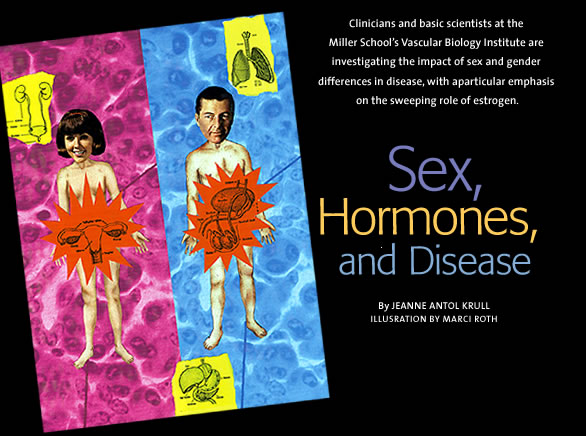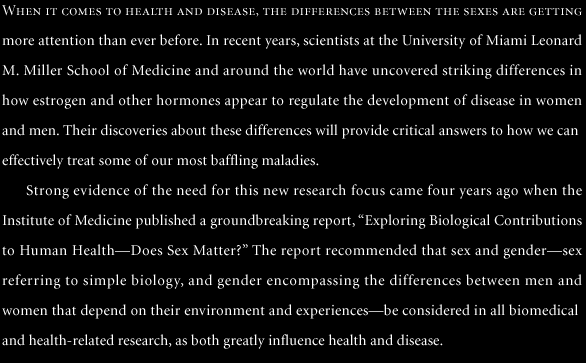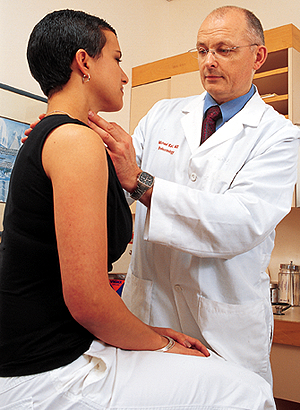 |
|
 |
![]() asic scientists and physician-scientists, working
out of the Vascular Biology Institute (VBI) at the Miller School of Medicine,
are meeting
the challenge. For several years they have been conducting research at
the translational level to study sex and gender differences in disease
presentation. In particular, they are looking at the all-encompassing
role of estrogen, one of the most powerful molecules in the human body,
and how it responds differently in women than in men.
asic scientists and physician-scientists, working
out of the Vascular Biology Institute (VBI) at the Miller School of Medicine,
are meeting
the challenge. For several years they have been conducting research at
the translational level to study sex and gender differences in disease
presentation. In particular, they are looking at the all-encompassing
role of estrogen, one of the most powerful molecules in the human body,
and how it responds differently in women than in men.
“We are really a multidisciplinary group made up of M.D.’s and Ph.D.’s looking at the disease process encompassing many different organs and tissues,” says Sharon Elliot, Ph.D., associate research professor in the Department of Medicine, who oversees most of the experiments in the VBI. As she explains it, “We’ve taken what the M.D.’s have seen in their clinical practice and are now testing out the theories in the laboratory.”

The faculty members at the VBI are targeting estrogen
and hormone regulation in several key organs: kidneys, eyes, lungs, and
skin. Each organ taken
alone has a very different disease presentation and frequency in women
than in men, and in almost all the organ systems it comes down to estrogen
![]()
![]()
![]()

![]()
![]()

![]()
![]()
![]()
“Looking at our current data, what we have found is that different organs, different tissues, and different diseases respond quite differently to sex hormones, depending on your sex and gender,” says Michael Karl, M.D., an assistant professor of clinical medicine in the Division of Endocrinology, Diabetes and Metabolismin the Department of Medicine
Consider these numbers from the National Center for Health Statistics: Before puberty, asthma is more prevalent in boys, with about 3.5 million suffering from the disease compared with 2.5 million girls; but after puberty, females with asthma outnumber males almost two to one. According to the U.S. Renal Data Services, there is a much higher incidence of middle-aged men developing kidney disease related to diabetes, but after menopause more women present with chronic kidney disease related to diabetes. It’s even more pronounced among women from certain minority groups such as African Americans, Hispanics, and Pacific Islanders.
“In some of our experiments, when we gave estrogen to menopausal female mice, we found it to be protective against kidney disease. Then we took it away from them and gave it back yet again at a later time to see the reaction,” says Karl. “What we found was that once we took it away, it never helped protect against kidney disease again. We strongly suspect it’s not just about estrogen—it could be about the ratio between estrogen and testosterone and how it changes during the aging process.”
There is no doubt men and women respond differently to testosterone. “A low level of testosterone in a man might lead to fatigue or to a low sex drive. But if a woman had that exact same testosterone level, she would develop masculine characteristics, such as growing facial hair and developing a deeper voice,” explains Karl. “Those differences are why this is such a growing field of research.”
A possible new avenue to explore is the difference in thyroid cancer between the sexes. According to the National Cancer Institute, many more women get thyroid cancer than men.
“But here’s the catch,” says Karl, “while more women get the disease, more men die from it, so could estrogen or some other hormone be protecting the women but harming the men?”
![]() strogen appears to play a big role in age-related macular
degeneration, the leading cause of blindness in the elderly. Epidemiological
studies
suggest the further past menopause a woman is, the worse her macular
degeneration becomes. Researchers believe the loss of estrogen at menopause
triggers
a biological process that accelerates the disease process.
strogen appears to play a big role in age-related macular
degeneration, the leading cause of blindness in the elderly. Epidemiological
studies
suggest the further past menopause a woman is, the worse her macular
degeneration becomes. Researchers believe the loss of estrogen at menopause
triggers
a biological process that accelerates the disease process.
“Using the same type of models we used to look at estrogen’s impact on the kidney and other organs, we looked at what disease mechanisms for macular degeneration get triggered by the lack of estrogen, so we can approach it from a different point of view,” Elliot says. “We’re looking at timing, when it occurs, and what triggers it, so you can stop it.”
 |
||
 |
||
The role of estrogen and the way sex and gender influence lung disease are so dominating that an entire volume of Clinics in Chest Medicine was devoted to the subject. “The typical patient with chronic obstructive pulmonary disease is more likely to be a woman, develops the disease younger than her male counterpart, and in many cases has no smoking exposure,” says Marilyn Glassberg, M.D., one of the guest editors of the book and associate professor in the Division of Pulmonary Medicine and Critical Care in the Department of Medicine.
One lung disease unique to women, and seemingly ruled by estrogen, is lymphangioleiomyomatosis, or LAM. In this rare disease an unusual type of muscle cell invades the lungs, forming bundles that grow into the walls of the airways and form cysts that completely destroy the lungs.
The disease almost exclusively affects women of childbearing age, but women who get it after menopause have one factor in common: “All of the women who present with LAM after menopause are on hormone replacement,” Glassberg says. “We also know that women who took birth control pills seem to present earlier when they get the disease, so it looks like it accelerates the disease. All contributing factors point to hormones in the woman’s environment, so that leads us back to estrogens and what role they’re playing in this disease.” As of now, a lung transplant is the only treatment. But one of the first clinical trials to investigate a possible drug treatment for LAM is being conducted based on research conducted at the VBI.
Why is there such a difference between the sexes in lung disease? Glassberg believes several risk factors could be at work, including birth control pills and smoking.
Could estrogen again be the triggering factor in why smoking affects women differently than men? Investigators at the VBI are trying to find out. According to a 2001 study in The Lancet Oncology, women exposed to smoke are twice as likely to develop lung cancer as men; nonsmokers who develop lung cancer are two-and-a-half times more likely to be female than male; and women who died from lung cancer were younger than men who died from the disease.
“The once-held belief that men were at greater risk for lung cancer resulted in most experimental studies being conducted in male animals,” Glassberg says. “Increasing numbers of women smoke, and they are particularly sensitive to the development of smoking-related pulmonary disease, and we need to figure out why.”
Glassberg and Elliot are conducting experiments with premenopausal and postmenopausal mice exposed to smoke. Using a device called the Teague machine, the mice are exposed to the smoke of six to eight cigarettes a day. “Dr. Elliot looks at what the smoke does to the kidneys, and I look at the lungs,” Glassberg says. “Women seem to be more susceptible to the effects of smoking, but we don’t know why.”
What happens to the biggest organ in the body when it is exposed to smoke? It’s already known that a smoker’s skin becomes damaged much earlier in life. The Division of Plastic, Reconstructive and Aesthetic Surgery has a full-time research fellow working at the VBI to further explore that damage. “The great thing about the Vascular Biology Institute is that these experiments are already in place for studying this type of thing, and you can utilize every tissue in every experiment to the fullest,” says Seth Thaller, M.D., chief of the plastic surgery division.
The collaboration between clinicians and basic scientists at the Vascular Biology Institute is one of the hallmarks of an academic medical center. “It’s a perfect marriage,” Thaller says, “to take what we see clinically, see if we can observe in the lab why it happens, and then try to modulate it clinically.
“That’s how true scientific and clinical progress is made.”
![]()